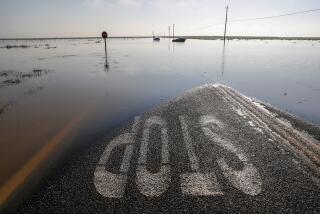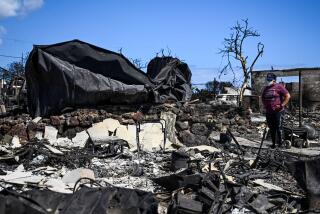Editorial: It’s OK to bend the rules to make Californians safer from wildfire

Gov. Gavin Newsom declared Friday what had already become apparent last year: California needs an emergency response to reduce the risk of more deadly, devastating wildfires.
Fire officials have long warned that California is facing a growing threat. An epidemic of dead and dying trees, a profusion of dry vegetation, the effects of climate change and the development of homes in high fire-risk areas have all laid the foundation for the extreme fires that raged across the state over last two years, killing more than 100 people and charring or destroying thousands of homes. Last year was the worst fire year in modern state history.
While lawmakers have approved billions in new funding in recent years to help with fire prevention, Newsom took it a step further by declaring a state of emergency, thereby suspending environmental and regulatory review requirements for certain fire-risk reduction projects and allowing the state to hire companies for those projects without competitive bidding.
The governor’s order specifically waives the normal requirements for 35 priority projects near high-risk communities, from Malibu to Big Sur to Ukiah. They include projects to cut down dead and hazardous trees, clear brush, bulldoze fire lines, carry out controlled burns and create additional evacuation routes. The latter was a big issue in Paradise, where residents fleeing the Camp Fire got trapped in traffic. The 35 projects were chosen based on both the fire risk facing the communities in question and the vulnerability of the population; that meant considering whether areas had higher numbers of residents with disabilities, seniors, non-English speakers and households without a car.
California needs an emergency response to reduce the risk of more deadly, devastating wildfires.
Bending the rules for those projects makes sense. After the death and human suffering witnessed in Paradise, Redding and Santa Rosa, it would be callous and utterly careless for California to let process and procedures slow the vital work needed to make the most threatened communities safer.
Environmental groups quickly lined up in opposition, arguing that Newsom’s decision to shortcut regulations is “Trumpian.” Indeed, President Trump has regularly and wrongly blamed “bad environmental laws” for wildfires, and his allies in Congress have sought to relax environmental laws to allow more commercial logging in the national forests.
But there’s a big difference between the kind of large-scale logging that the Trump administration has proposed and the targeted “fuel reduction” projects around vulnerable communities that the California Department of Forestry and Fire Protection has planned. Newsom’s order is narrow and conservative, applying to the riskiest of the high-risk areas. The 35 projects that would be exempted from environmental regulations represent a tiny fraction of the public and private lands that need attention. In fact, the order would affect only about 90,000 acres, compared with an estimated 15 million acres of forest that need restoration, plus the vast stretches of dense and highly flammable shrub lands across Southern California.
And it’s not like all environmental protections will be lifted for these projects. The heads of the California Environmental Protection Agency and Natural Resources Agency would still need to sign off on the projects to make sure the work adequately protects the public health and the environment.
Enter the Fray: First takes on the news of the minute »
Of course, even with an emergency declaration, California won’t be able to reduce risks significantly before the coming wildfire season. The state has to catch up with decades of deferred maintenance in its wild-land areas. Then, there are some 2.2 million homes in the wild-land-urban interface where houses and businesses abut foothills, forests or other open land. Many of those properties need to be retrofitted to make them fire resistant.
Newsom’s order is really a down payment on the work that lies ahead. Sure, streamline environmental regulations for few dozen fire-safety projects. But if California is truly in a “condition of extreme peril,” then the state needs far more radical interventions, including curtailing housing development in previously undeveloped, high-fire-risk areas and forcing utilities to reduce the fire risk from their power lines.
This isn’t an emergency that will end any time soon.
Follow the Opinion section on Twitter @latimesopinion and Facebook
More to Read
A cure for the common opinion
Get thought-provoking perspectives with our weekly newsletter.
You may occasionally receive promotional content from the Los Angeles Times.






